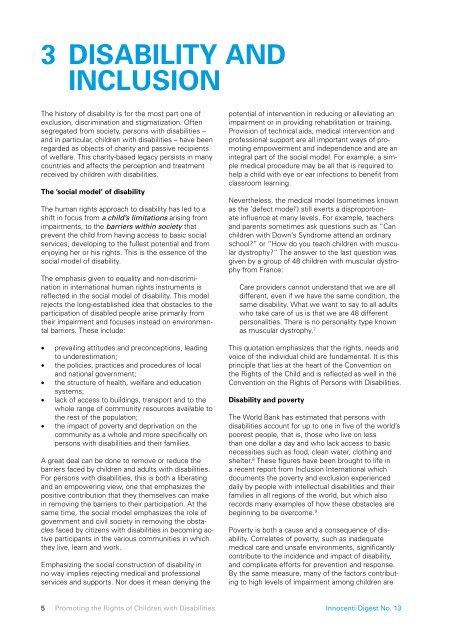Promoting the Rights of Children with Disabilities, UNICEF
Promoting the Rights of Children with Disabilities, UNICEF
Promoting the Rights of Children with Disabilities, UNICEF
- No tags were found...
You also want an ePaper? Increase the reach of your titles
YUMPU automatically turns print PDFs into web optimized ePapers that Google loves.
3 DISABILITY ANDINCLUSIONThe history <strong>of</strong> disability is for <strong>the</strong> most part one <strong>of</strong>exclusion, discrimination and stigmatization. Oftensegregated from society, persons <strong>with</strong> disabilities –and in particular, children <strong>with</strong> disabilities – have beenregarded as objects <strong>of</strong> charity and passive recipients<strong>of</strong> welfare. This charity-based legacy persists in manycountries and affects <strong>the</strong> perception and treatmentreceived by children <strong>with</strong> disabilities.The ’social model’ <strong>of</strong> disabilityThe human rights approach to disability has led to ashift in focus from a child’s limitations arising fromimpairments, to <strong>the</strong> barriers <strong>with</strong>in society thatprevent <strong>the</strong> child from having access to basic socialservices, developing to <strong>the</strong> fullest potential and fromenjoying her or his rights. This is <strong>the</strong> essence <strong>of</strong> <strong>the</strong>social model <strong>of</strong> disability.The emphasis given to equality and non-discriminationin international human rights instruments isreflected in <strong>the</strong> social model <strong>of</strong> disability. This modelrejects <strong>the</strong> long-established idea that obstacles to <strong>the</strong>participation <strong>of</strong> disabled people arise primarily from<strong>the</strong>ir impairment and focuses instead on environmentalbarriers. These include:• prevailing attitudes and preconceptions, leadingto underestimation;• <strong>the</strong> policies, practices and procedures <strong>of</strong> localand national government;• <strong>the</strong> structure <strong>of</strong> health, welfare and educationsystems;• lack <strong>of</strong> access to buildings, transport and to <strong>the</strong>whole range <strong>of</strong> community resources available to<strong>the</strong> rest <strong>of</strong> <strong>the</strong> population;• <strong>the</strong> impact <strong>of</strong> poverty and deprivation on <strong>the</strong>community as a whole and more specifically onpersons <strong>with</strong> disabilities and <strong>the</strong>ir families.A great deal can be done to remove or reduce <strong>the</strong>barriers faced by children and adults <strong>with</strong> disabilities.For persons <strong>with</strong> disabilities, this is both a liberatingand an empowering view, one that emphasizes <strong>the</strong>positive contribution that <strong>the</strong>y <strong>the</strong>mselves can makein removing <strong>the</strong> barriers to <strong>the</strong>ir participation. At <strong>the</strong>same time, <strong>the</strong> social model emphasizes <strong>the</strong> role <strong>of</strong>government and civil society in removing <strong>the</strong> obstaclesfaced by citizens <strong>with</strong> disabilities in becoming activeparticipants in <strong>the</strong> various communities in which<strong>the</strong>y live, learn and work.Emphasizing <strong>the</strong> social construction <strong>of</strong> disability inno way implies rejecting medical and pr<strong>of</strong>essionalservices and supports. Nor does it mean denying <strong>the</strong>potential <strong>of</strong> intervention in reducing or alleviating animpairment or in providing rehabilitation or training.Provision <strong>of</strong> technical aids, medical intervention andpr<strong>of</strong>essional support are all important ways <strong>of</strong> promotingempowerment and independence and are anintegral part <strong>of</strong> <strong>the</strong> social model. For example, a simplemedical procedure may be all that is required tohelp a child <strong>with</strong> eye or ear infections to benefit fromclassroom learning.Never<strong>the</strong>less, <strong>the</strong> medical model (sometimes knownas <strong>the</strong> ’defect model’) still exerts a disproportionateinfluence at many levels. For example, teachersand parents sometimes ask questions such as “Canchildren <strong>with</strong> Down’s Syndrome attend an ordinaryschool?” or “How do you teach children <strong>with</strong> musculardystrophy?” The answer to <strong>the</strong> last question wasgiven by a group <strong>of</strong> 48 children <strong>with</strong> muscular dystrophyfrom France:Care providers cannot understand that we are alldifferent, even if we have <strong>the</strong> same condition, <strong>the</strong>same disability. What we want to say to all adultswho take care <strong>of</strong> us is that we are 48 differentpersonalities. There is no personality type knownas muscular dystrophy. 7This quotation emphasizes that <strong>the</strong> rights, needs andvoice <strong>of</strong> <strong>the</strong> individual child are fundamental. It is thisprinciple that lies at <strong>the</strong> heart <strong>of</strong> <strong>the</strong> Convention on<strong>the</strong> <strong>Rights</strong> <strong>of</strong> <strong>the</strong> Child and is reflected as well in <strong>the</strong>Convention on <strong>the</strong> <strong>Rights</strong> <strong>of</strong> Persons <strong>with</strong> <strong>Disabilities</strong>.Disability and povertyThe World Bank has estimated that persons <strong>with</strong>disabilities account for up to one in five <strong>of</strong> <strong>the</strong> world’spoorest people, that is, those who live on lessthan one dollar a day and who lack access to basicnecessities such as food, clean water, clothing andshelter. 8 These figures have been brought to life ina recent report from Inclusion International whichdocuments <strong>the</strong> poverty and exclusion experienceddaily by people <strong>with</strong> intellectual disabilities and <strong>the</strong>irfamilies in all regions <strong>of</strong> <strong>the</strong> world, but which alsorecords many examples <strong>of</strong> how <strong>the</strong>se obstacles arebeginning to be overcome. 9Poverty is both a cause and a consequence <strong>of</strong> disability.Correlates <strong>of</strong> poverty, such as inadequatemedical care and unsafe environments, significantlycontribute to <strong>the</strong> incidence and impact <strong>of</strong> disability,and complicate efforts for prevention and response.By <strong>the</strong> same measure, many <strong>of</strong> <strong>the</strong> factors contributingto high levels <strong>of</strong> impairment among children are5 <strong>Promoting</strong> <strong>the</strong> <strong>Rights</strong> <strong>of</strong> <strong>Children</strong> <strong>with</strong> <strong>Disabilities</strong> Innocenti Digest No. 13
















